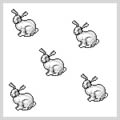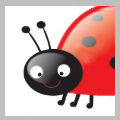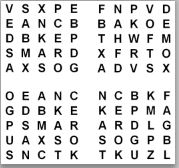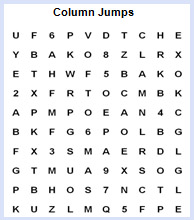Tracking: Saccades
Saccades refer to the eye’s ability to quickly and accurately shift from one target to another. This is a critical skill in reading, involving very specific eye movements. The eyes must move left to right along a straight line without deviating up or down to the lines above or below. In addition, when we reach the end of a line, our eyes must make a difficult reverse sweep back to the beginning of the next line. If a child cannot control these eye movements, he’ll lose his place and comprehension becomes a problem. The exercises below are meant to improve this important tracking skill.
Helpful Hint: If head movement is a problem for the child, place a bean bag or stuffed toy on his/her head as a reminder to hold the head still.
 Click on the link to go to this exercise. Rabbit Jumps
Click on the link to go to this exercise. Rabbit Jumps- This activity is challenging because the target is the same color as the background, offering less contrast.
- Watch as the rabbit jumps around the screen, moving only your eyes and not your head. The inability to move the eyes without also moving the head is usually an indication of deficits in the oculomotor system.
- Parents: If your child has trouble doing this exercise with both eyes, try having him/her cover one eye. Continue to work this activity with one eye at a time until performance improves; then work both eyes.
![]() Bug Jumps with Motor Demand. PART I
Bug Jumps with Motor Demand. PART I
 Click on the link to go to this exercise. Bug Jumps
Click on the link to go to this exercise. Bug Jumps- Touch the bug with your index (pointer) finger before he moves. This activity not only helps your eye movements but also works visual motor integration, the ability of our eyes to direct our hands.
- As you work, move only your eyes and hands, not your head.
PART II
 Click on the link to go to this exercise. Bug Jumps, Fast
Click on the link to go to this exercise. Bug Jumps, Fast- This time the bugs jump faster to increase the demand level.
- Repeat the exercise as above. However, this time alternate hand: right, left, right, left, etc.
- As you work, move only your eyes and hands, not your head.
 Download and print this worksheet. FOUR SQUARE SACCADES
Download and print this worksheet. FOUR SQUARE SACCADES- Cut the worksheet up into four squares and tape the squares on a wall, each 3-4 feet apart.
- Stand 10-15 feet away.
- Read the first letter on the first line from each square, then second letter from each square, etc., working all the way through every letter on all four squares until you reach the end.
- Remember to move only your eyes and not your head.
- Bring it Home: Add a motor demand. Perform the task while walking forward heel-to-toe toward the squares and then walking backwards toe-to-heel while reading the letters.
- Click on the links below to complete this exercise.
- Read the numbers left to right as they appear on the screen.
- Move only your eyes, not your head.
- Start with the slow speed; if it is too easy, move on the medium speed.
- Once the medium skill is mastered, repeat using the fast speed.
- The goal is to read the numbers easily, smoothly, and accurately.
- Parents: If your child has trouble doing this exercise with both eyes, try having him/her cover one eye. Continue to work this activity with one eye at a time until performance improves; then work both eyes.
SLOW NUMBER SACCADES MEDIUM NUMBER SACCADES FAST NUMBER SACCADES
- Click on the links below for some fun mazes to help improve oculomotor function.
- Follow the path with your eyes. Do not use your finger, do not move your head.
- Parents: If your child has trouble doing this exercise with both eyes, try having him/her cover one eye. Continue to work this activity with one eye at a time until performance improves; then work both eyes.
- Download and print the Alphabet Mazes worksheets. ALPHABET MAZES
- There are 11 pages in this set of worksheets that are designed to integrate vision tracking skills with our fine motor system.
- Follow the path from the picture to the center letters. Do not use your finger, only your eyes. Do not move your head.
- Next, using a pencil draw a line from the picture to the center picture. Stay in the center of the path; do not touch the sides.
![]() Alphabet Saccades: Sound-Symbol Integration.
Alphabet Saccades: Sound-Symbol Integration.
- Download and print the Alphabet Saccades worksheets. ALPHABET SACCADES
- There are 13 pages in this set of worksheets that are designed to integrate vision with sound-symbol integration.
- Underline each target letter while you say the sound the letter makes. (Remember, don’t say the letter name; say the sound).
- Work as quickly and accurately as possible. Do not move your head.
- Check your work. Using a different colored pencil or pen, go back through and circle any letters you may have missed.
![]() .
.
- Click on the links to the Line Twine exercises below, a series of intertwined lines.
- The object is to correctly follow the line from it’s beginning to its end.
- Lines will not make any dramatic turns. When two lines cross, follow the line across the intersection.
- Remember to “eye” the path without using your finger.
- Parents: If your child has trouble doing this exercise with both eyes, try having him/her cover one eye. Continue to work this activity with one eye at a time until performance improves; then work both eyes.
Animal Babies 1 Animal Babies 2
Nursery Rhymes 1 Nursery Rhymes 2
Alphabet Line Twines with Visual Motor Integration.
- Print off the worksheets for the Alphebet Line Twine exercises: ALPHABET LINE TWINES
- “Eye” the exercises first; do not use your finger.
- Bring It Home: Trace the lines with a pencil, being careful to stay on the line as closely as possible.
.
 Download and print this worksheet, a grid of 100 letters and numbers. COLUMN JUMPS
Download and print this worksheet, a grid of 100 letters and numbers. COLUMN JUMPS- Put the chart on the wall and stand 16-20 inches back.
- Read the the first, fifth, and tenth letters in the first line, then the first, fifth, and tenth letters of the second line, etc. In other words, read letters across working down the 1st, 5th, and 10th columns.
- When this is mastered, vary the vertical columns: second, sixth, and eighth; third, sixth, and ninth, etc.
- Load the Activity: Once this is mastered, add rhythmic demands by clapping out a beat or using a metronome while the child reads the letters to the beat.
- Now follow the same process using one of the smaller charts, cut out with enough margin that it can be held in the hand. Hold 16 inches in front of the eyes.
- Parents: If your child has trouble doing this exercise with both eyes, try having him/her cover one eye. Continue to work this activity with one eye at a time until performance improves; then work both eyes.
- Bring It Home: Add an accommodative (focusing) demand: Bring the small target as close to the eyes as you can and still keep it clear: 4-6 inches. If the print blurs or doubles, cover one eye with your hand and work each eye separately until the task becomes easier. Note: Any double vision is not normal and is a strong indication you need to seek an evaluation by a developmental optometrist. Go to covd.org to find a doctor in your area.
![]() Super Saccades.
Super Saccades.
- Download and print this worksheet. SUPER SACCADES
- Part I. Says the first letter of the top line and then the first letter of the bottom line, then the second letter of the top line and the second letter of the bottom line, continuing across the rows. Repeats the process, reading letters from the 2nd and 9th rows, then the 3rd and 8th rows, and end with the 4th and 7th rows.
- Part II. Read the 1st letter of the first column and 1st letter of the last column; then 2nd letter of the first column and 2nd letter of the last column, etc., until you reach the bottom of columns 1 and 10. Repeat the process with columns 2 and 9, 3 and 8, 4 and 7.
- Parents: If your child has trouble doing this exercise with both eyes, try having him/her cover one eye. Continue to work this activity with one eye at a time until performance improves; then work both eyes.
- For many children, this is a challenging activity, so feel free to modify the demand until the child’s skill improves. For example, you may want to start with just the two outside rows at a time since it’s harder to keep your place in the inner rows. You may want to allow the child to use his finger in the beginning to help guide his eye. However, as the child’s ability improves, remove the modifications until he/she can complete the entire chart without using his/her finger and without moving his head.
- Load the Activity: Once the child master the large chart, use one of the smaller charts to repeat the exercise. Use each eye, then both.
- Bring It Home: Download a metronome app on your smart phone or computer and have the child say the letters to the beat.


CLICK HERE TO GO TO TRACKING PURSUIT EXERCISES.

